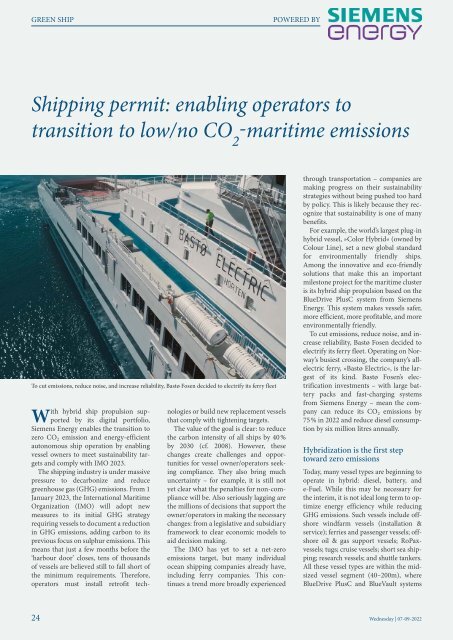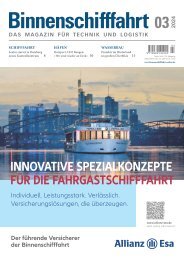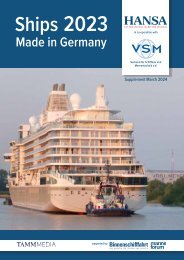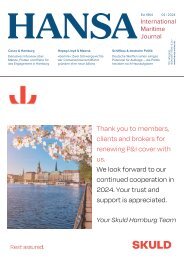HANSA SMM DAILY Newswire - Day 2
HANSA’s daily SMM trade show newspaper - Day 2 edition
HANSA’s daily SMM trade show newspaper - Day 2 edition
- No tags were found...
Create successful ePaper yourself
Turn your PDF publications into a flip-book with our unique Google optimized e-Paper software.
GREEN SHIP<br />
POWERED BY<br />
Shipping permit: enabling operators to<br />
transition to low/no CO 2<br />
-maritime emissions<br />
To cut emissions, reduce noise, and increase reliability, Bastø Fosen decided to electrify its ferry fleet<br />
With hybrid ship propulsion supported<br />
by its digital portfolio,<br />
Siemens Energy enables the transition to<br />
zero CO 2 emission and energy-efficient<br />
autonomous ship operation by enabling<br />
vessel owners to meet sustainability targets<br />
and comply with IMO 2023.<br />
The shipping industry is under massive<br />
pressure to decarbonize and reduce<br />
greenhouse gas (GHG) emissions. From 1<br />
January 2023, the International Maritime<br />
Organization (IMO) will adopt new<br />
measures to its initial GHG strategy<br />
requiring vessels to document a reduction<br />
in GHG emissions, adding carbon to its<br />
previous focus on sulphur emissions. This<br />
means that just a few months before the<br />
‘harbour door’ closes, tens of thousands<br />
of vessels are believed still to fall short of<br />
the minimum requirements. Therefore,<br />
operators must install retrofit technologies<br />
or build new replacement vessels<br />
that comply with tightening targets.<br />
The value of the goal is clear: to reduce<br />
the carbon intensity of all ships by 40 %<br />
by 2030 (cf. 2008). However, these<br />
changes create challenges and opportunities<br />
for vessel owner/operators seeking<br />
compliance. They also bring much<br />
uncertainty – for example, it is still not<br />
yet clear what the penalties for non-compliance<br />
will be. Also seriously lagging are<br />
the millions of decisions that support the<br />
owner/operators in making the necessary<br />
changes: from a legislative and subsidiary<br />
framework to clear economic models to<br />
aid decision making.<br />
The IMO has yet to set a net-zero<br />
emissions target, but many individual<br />
ocean shipping companies already have,<br />
including ferry companies. This continues<br />
a trend more broadly experienced<br />
through transportation – companies are<br />
making progress on their sustainability<br />
strategies without being pushed too hard<br />
by policy. This is likely because they recognize<br />
that sustainability is one of many<br />
benefits.<br />
For example, the world’s largest plug-in<br />
hybrid vessel, »Color Hybrid« (owned by<br />
Colour Line), set a new global standard<br />
for environmentally friendly ships.<br />
Among the innovative and eco-friendly<br />
solutions that make this an important<br />
milestone project for the maritime cluster<br />
is its hybrid ship propulsion based on the<br />
BlueDrive PlusC system from Siemens<br />
Energy. This system makes vessels safer,<br />
more efficient, more profitable, and more<br />
environmentally friendly.<br />
To cut emissions, reduce noise, and increase<br />
reliability, Bastø Fosen decided to<br />
electrify its ferry fleet. Operating on Norway’s<br />
busiest crossing, the company’s allelectric<br />
ferry, »Bastø Electric«, is the largest<br />
of its kind. Bastø Fosen’s electrification<br />
investments – with large battery<br />
packs and fast-charging systems<br />
from Siemens Energy – mean the company<br />
can reduce its CO 2 emissions by<br />
75 % in 2022 and reduce diesel consumption<br />
by six million litres annually.<br />
Hybridization is the first step<br />
toward zero emissions<br />
Today, many vessel types are beginning to<br />
operate in hybrid: diesel, battery, and<br />
e-Fuel. While this may be necessary for<br />
the interim, it is not ideal long term to optimize<br />
energy efficiency while reducing<br />
GHG emissions. Such vessels include offshore<br />
windfarm vessels (installation &<br />
service); ferries and passenger vessels; offshore<br />
oil & gas support vessels; RoPaxvessels;<br />
tugs; cruise vessels; short sea shipping;<br />
research vessels; and shuttle tankers.<br />
All these vessel types are within the midsized<br />
vessel segment (40–200m), where<br />
BlueDrive PlusC and BlueVault systems<br />
24<br />
Wednesday | 07-09-2022


















